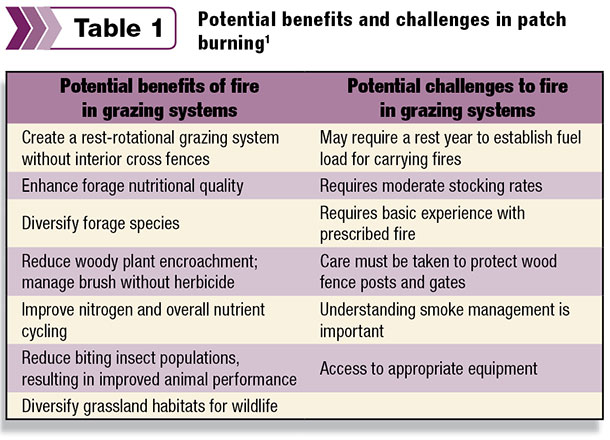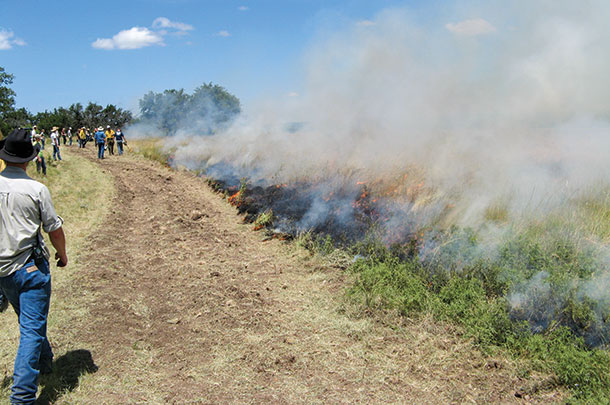Patch burning is the application of prescribed fire to focus livestock grazing on a portion of the pasture. Benefits of the practice are increased diversity and structure of vegetation resulting in improved wildlife habitat and maintenance of livestock production.
Vegetation structure is defined as the organization of individuals in a stand of plants. The structure could be one species or a diversity of plants. Plant community structure can change when the original plants are unable to compete with invasive plants or from disturbance such as fire, drought or overgrazing.
Patch-burn grazing is an alternative to traditional intensive grazing systems. Instead of depending on interior fencing to focus grazing in a portion of a pasture, a manager uses post-fire regrowth to attract cattle to selected areas. At the same time, other portions of the unit remain open to grazing but are underutilized, thereby allowing plants to rest while root reserves are restored.
American Indians used patch burning to attract bison and other grazing animals, so it is not a new concept. “In contrast to common belief, bison were largely resident animals, not migratory,” says Steve Clubine, a grassland management consultant based in Missouri.
“Bison followed fire that was either started by lightning or by the Indians. They heavily grazed fresh burns and lightly grazed other areas during warm weather and made greater use of riparian and unburned areas in the winter.
“Indians burned to ensure forage for native grazers, create usable habitat for wildlife and to keep underbrush down for travel and farming,” Clubine continues.
“Indians left a significant amount of areas unburned to promote fall and winter forage where bison and elk could be hunted. This resulted in a shifting mosaic of plant and structural diversity that was critical for good wildlife habitat.”
Pros and cons
“Combining fire and grazing for biodiversity manipulates plant competition,” says Dr. Morgan Russell, Texas A&M AgriLife Extension Service. “Grasslands dominated by perennial grasses do not have root space or available light for new plant establishment. Severe grazing forces plants to reduce root structures."
"The smaller root mass and increased light allows new plants to establish. New plants can compete for space as dominant plants recover.”
“Fire is used to favor desirable plants, increase forage palatability and availability and suppress brush,” says John Hughes, U.S. Fish and Wildlife Service (FWS). “It is a good clean-up treatment following mechanical or herbicidal brush control."
"Fire removes old, decadent grass growth and promotes nutrient cycling. It can also provide short-term control of insects and parasites. Judicious use of fire can reduce the likelihood of future catastrophic fires.”
 “Patch-burn grazing takes advantage of a grazing animal’s instinctive attraction to fresh, highly nutritious forage regrowth following a fire,” says Jesse Randall, Iowa State University Extension. “By burning a discrete portion of a pasture or grassland tract each year, grazers naturally spend most of their time foraging in the new regrowth, and avoid unburned areas with standing dead plant material and thicker litter."
“Patch-burn grazing takes advantage of a grazing animal’s instinctive attraction to fresh, highly nutritious forage regrowth following a fire,” says Jesse Randall, Iowa State University Extension. “By burning a discrete portion of a pasture or grassland tract each year, grazers naturally spend most of their time foraging in the new regrowth, and avoid unburned areas with standing dead plant material and thicker litter."
"Repeating this process annually or semi-annually, using a dormant and growing season fire, essentially creates a rest-rotational grazing system without using interior fencing. Cattle or other grazing animals are relied upon to move in response to new forage growth. The result is a landscape where each burn unit receives several years’ rest from fire and grazing."
"Plant diversity and wildlife habitat are enhanced, and grazing animal performance is equal to or better than traditional pasture management practices.”
“Fire is an essential management tool; however, there are challenges to its use,” explains Hughes. “There is a steep learning curve in safe, effective use of prescribed fire. Some of the biggest concerns are landowner liability and safety to people and buildings. Smoke management can create a problem, especially near municipalities. Neighbors and some resource agencies might be resistant to the practice of prescribed fire.”
How to do it
“Before initiating a patch-burn program, planning is necessary,” cautions Hughes. “Identify goals that are definable and realistic. Are you managing for wildlife, livestock or both? Burn plans are required and in most states, they have to be approved by the appropriate agency or authorities."
 "Applications for cost-share assistance may be available from National Resources Conservation Service (NRCS), state wildlife or natural resource departments and FWS. Access to necessary resources such as people, pumper trucks, all-terrain vehicles (ATVs), drip torches, hand tools (shovels, axes and other fire-fighting devices), two-way radios, weather monitoring kits and protective gear is very important.”
"Applications for cost-share assistance may be available from National Resources Conservation Service (NRCS), state wildlife or natural resource departments and FWS. Access to necessary resources such as people, pumper trucks, all-terrain vehicles (ATVs), drip torches, hand tools (shovels, axes and other fire-fighting devices), two-way radios, weather monitoring kits and protective gear is very important.”
“Implementing prescribed fire management in a patch-burn grazing system can be tricky at the outset, as some internal firebreaks are necessary to create a burn patch within a larger pasture,” says Randall.
“Firebreaks can be roads, crop fields, ponds or streams, or they can be created by mowing, grading or light disking. Once implemented, patch-burn grazing can make prescribed fire management easier because the patch grazed the previous year can be used as a fire break.
 “Using prescribed fire as a management tool in a practice such as patch-burn grazing requires enough fuel to carry a fire the following season,” Randall continues. “Thus, it is important to use a moderate stocking rate in order to leave some residue with which to carry a prescribed fire. The exact stocking rate depends on the goals for an individual pasture. Start with conservative stocking and then adjust as needed.
“Using prescribed fire as a management tool in a practice such as patch-burn grazing requires enough fuel to carry a fire the following season,” Randall continues. “Thus, it is important to use a moderate stocking rate in order to leave some residue with which to carry a prescribed fire. The exact stocking rate depends on the goals for an individual pasture. Start with conservative stocking and then adjust as needed.
“Patch-burn grazing can be an appropriate and effective management practice for many sites, though plant community needs must be considered. Understand the plant community and soil properties of your site. In order to write an effective grazing management plan, also understand the inherent differences between species, breed and class of animals to be grazed.”
Fire is a critical natural process for ecosystem management, providing a means for renewal, regrowth and maintenance of vegetation for grazing lands and wildlife habitat. ![]()
PHOTO 1: Prescribed fires are normally started with a drip torch.
PHOTO 2: One of the needed pieces of equipment is ATVs equipped with sprayers for putting out small blazes started by sparks that might blow over the fire break.
PHOTO 3: Roads make good firebreaks. Photos by Robert Fears.

-
Robert Fears
- Freelance Writer
- Georgetown, Texas
- Email Robert Fears







